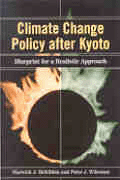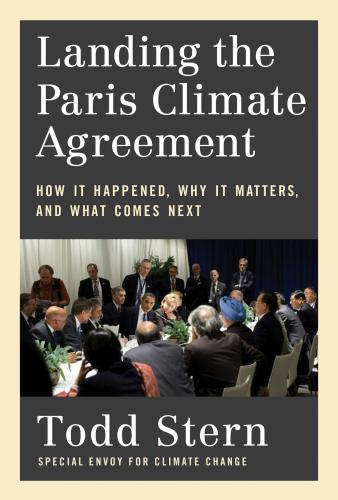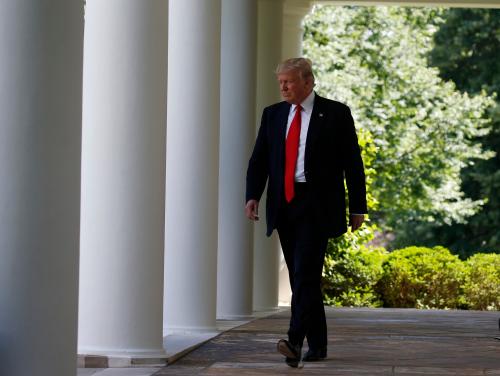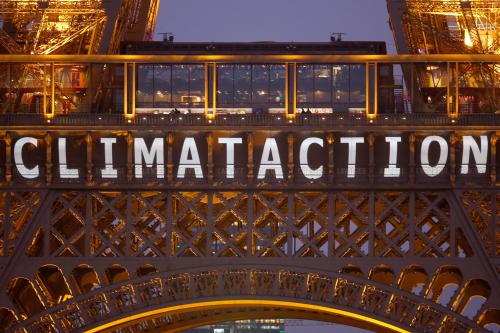President Donald Trump’s decision to pull the United States out of the Paris Agreement is bad for the U.S. and bad for the world, but has galvanized global commitments to the goals of climate stabilization and to the agreement itself.
The decision itself is a major error. The loss of American leadership hurts the ability of the international community to reach our scientifically grounded, global, long-term goals for reducing emissions to safer levels, and the president’s choice to lead the country back toward a 19th century energy economy will likely prove to be ill-conceived and bad for the American economy.
The decision also goes against the advice most of the country’s business elite. In his justification of the withdrawal, Trump cast Paris—a nonbinding structure to encourage international action on climate—as an unfair and heavily oppressive deal, and as the fount of phantasmagorical ills such as joblessness, economic stagnation, and trainloads of cash en route to a tricky cabal of conspirator states, including our allies. None of these claims is true or based on reputable analysis. To emphasize just two points, in contrast to Trump’s assertions, the structure of Paris means that nobody else dictates what the U.S.’s own goals should be, and China and India have indeed made significant commitments to emissions reduction and clean energy, which they are likely to meet or even exceed.
The speech itself, which erected a largely manufactured pretext for the withdrawal, was an embarrassment of falsehood and misrepresentation. In the style of his inaugural address, the speech was paranoid and apocalyptic, painting a vision of a world conspiring through international discussions to take advantage of the U.S. and extract funds. Since the announcement, there have been a myriad of detailed rebuttals published about the large number of false and misleading claims in Trump’s speech that I will not repeat here.
I have previously written about the many reasons for the U.S. to remain in the Paris Agreement, and how the Trump administration’s narrative about it is from a former era and not grounded in the reality of what Paris is, how the energy technology markets have fundamentally transformed, and the potential costs of inaction. These are important points to mind, and it is worth noting as a broad statement that the very structure of Paris was designed to address the kinds of concerns that Trump raised in his speech. So far, so predictable (if regrettable). But in the days since Trump’s announcement two notable outcomes have occurred that would not have been obvious beforehand.
First, the international coalition forged to deliver Paris has strengthened.
It is widely recognized that most international regimes such as the Paris Agreement survive by mutual agreement from sovereign country participants. This reality underpins the architecture of the Paris Agreement, which uses the dual principles of regularly revised, nationally determined actions and open reporting to encourage a cycle of positive action: if country A sees country B implementing an ambitious clean energy program, and succeeding, country A will be more likely to commit to its own, similarly ambitious program. When the major countries are moving forward together, that reassures them and other countries that continued action will be desirable. This was, in fact, the pattern seen in advance of the negotiation of Paris when countries put forward their national targets, starting with a surprise announcement by the world’s two biggest emitters, China and the U.S., a full year before the Paris negotiation itself. This announcement drew widespread positive attention and most other major countries subsequently announced solidly ambitious targets in advance of the negotiations, providing clarity on the significance of a potential successful outcome in Paris.
The concern about this model of the cycle of positive action is of course, that the cycle could cut in the opposite direction if the major countries fail to deliver or, like the U.S., withdraw. Any robust, long-term regime would have to be inured against such perturbations, but whether the architecture of the Paris Agreement was sufficient to withstand the loss of the world’s number two emitter and arguably the world’s climate leader was previously unclear.
The global consensus on the overall goals and the strong participation from leaders of the developing world underscore the dramatic shift that the Paris process and the agreement itself have initiated in the overall global conversation.
The response in the wake of Trump’s announcement has at least partly quelled those concerns. While the process will have to continue over years, not days, the initial responses from key international actors have been strong and supportive. Trump’s decision has moreover created a flood of discussion in many countries about not simply climate action in the abstract, but the singular importance of the Paris Agreement itself to a successful outcome. The other G-7 countries immediately issued a statement affirming their support, and the European Union and China also issued a strong joint statement on Paris and their commitment to the targets. India, too, recommitted to continuing to achieve its target. The global consensus on the overall goals and the strong participation from leaders of the developing world underscore the dramatic shift that the Paris process and the agreement itself have initiated in the overall global conversation. For a regime that depends on global support, the withdrawal of this one important actor seems to have clarified both the stakes and the global commitment to the process set out under Paris.
Second, the U.S. domestic response in support of Paris has been swift and broad.
Since Trump’s election, it has been clear that many states, cities, businesses, and other entities would attempt to take steps even without federal leadership, and in the face of a federal regulatory rollback. But the response to Trump’s announcement has been more rapid and more concrete than many thought likely, focusing specifically on retaining a commitment to both continuing progress toward broader climate goals as well as to the Paris Agreement itself. A recent Washington Post-ABC poll shows Americans prefer staying in the agreement by a margin of 2 to 1, with only 28 percent supporting the withdrawal. In the few days since the announcement, a broad group of over 1,200 U.S. actors, by their own reckoning representing 120 million Americans, have committed to working toward the goals of the Paris Agreement.
Former New York Mayor Michael Bloomberg has gone further and called on this coalition approach to deliver on the U.S. national climate target for 2025. Further supporting this, a group of 13 states led by California, Washington, and New York, representing roughly one-third of U.S. GDP, has established the U.S. Climate Alliance to support action to achieve the U.S. national target of 26-28 percent below 2005 emission levels by 2025. This is an audacious goal and would be difficult to achieve without federal regulatory or legislative action. However, the possibility of willing U.S. states increasing their climate targets, combined with continued surprisingly rapid decreases in the costs for clean energy technologies like solar, wind, and electric vehicles, can compensate, perhaps significantly, for the loss of federal action. For example, California—which would be the world’s sixth-largest economy if it were a country—is now considering a new and ambitious climate target of 100 percent renewable energy by 2045. It is conceivable that such enhanced actions, repeated across willing states and cities across the U.S., and with support from independent consumers in non-participating states, could achieve substantial reductions of emissions, particularly within the electricity and transportation sectors. While other areas such as industrial energy use and non-CO2 gases would be harder to incorporate, these upward shifts in ambition from willing actors will at a minimum make it more tractable for the U.S. to re-engage on a broader emissions reduction trajectory under a future administration.
The shifting of global energy economies toward more climate-friendly structures is already partly underway, but will take decades to complete. Nevertheless, near-term investment in a cleaner economy is necessary to provide the basis for this sustained shift. Trump’s decision to withdraw from Paris leaves a minimum four-year window during which the U.S. will not be supporting the international institutions to realize this shift, and will remove the important levers of federal action from driving domestic emissions reductions. Still, the surprisingly strong support for Paris from non-federal U.S. actors and from the international community provides an important indication of global commitment to sustaining the significant momentum that was generated over recent years. The main challenge is to sustain the cycle of positive action: for other countries to maintain their engagement with the process, and to keep a pathway for the U.S. to formally re-enter the process at a future date. The actions of the last week to move beyond Trump’s decision indicate the potential that this is still possible.
The Brookings Institution is committed to quality, independence, and impact.
We are supported by a diverse array of funders. In line with our values and policies, each Brookings publication represents the sole views of its author(s).










Commentary
The galvanized world response to Trump’s Paris Agreement decision
June 7, 2017